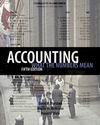 |  Accounting: What the Numbers Mean, 5/e David H. Marshall,
Millikin University
Wayne W. McManus,
International College of the Cayman Islands
Daniel F. Viele,
Webster University
Cost Analysis for Control
Chapter 15 Learning ObjectivesAfter studying this chapter, you should understand:
1.That all costs are controllable by someone at some time but that in the short run some costs may be classified as noncontrollable. |
 |  |  | 2.How performance reporting facilitates the management-by-exception process. |
 |  |  | 3.How the operating results of segments of organizations can be reported most meaningfully. |
 |  |  | 4.What a flexible budget is and how it is used. |
 |  |  | 5.How and why two components of a standard cost variance are calculated. |
 |  |  | 6.The specific names assigned to variances for different product inputs. |
 |  |  | 7.How the control and analysis of fixed overhead variances and variable cost variances differ. |
 |  |  | 8.The alternative methods of accounting for variances. |
|


 2002 McGraw-Hill Higher Education
2002 McGraw-Hill Higher Education